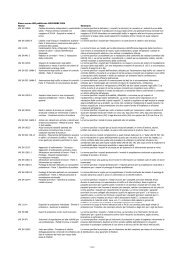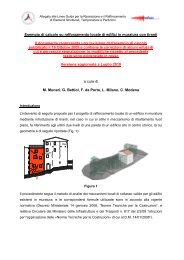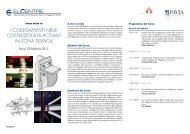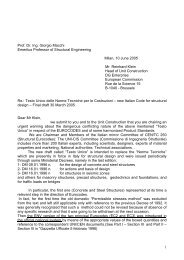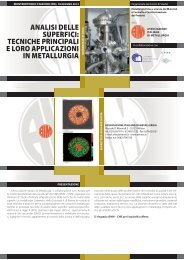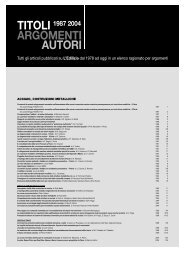Combinazioni di Verifica agli stati Limite: il non ... - Steelchecks.com
Combinazioni di Verifica agli stati Limite: il non ... - Steelchecks.com
Combinazioni di Verifica agli stati Limite: il non ... - Steelchecks.com
Create successful ePaper yourself
Turn your PDF publications into a flip-book with our unique Google optimized e-Paper software.
17<br />
Per tener conto <strong>di</strong> questo problema occorre generare una matrice quadrata booleana, la quale<br />
<strong>di</strong>ca, per ogni generico caso <strong>di</strong> carico variab<strong>il</strong>e I, se i casi <strong>di</strong> carico variab<strong>il</strong>i J (con J <strong>di</strong>verso da I)<br />
siano o meno ammessi ad essere contemporaneamente agenti rispetto ad I.<br />
Per fissare le idee consideriamo <strong>il</strong> seguente primo insieme <strong>di</strong> con<strong>di</strong>zioni <strong>di</strong> carico.<br />
Caso Nome sintetico Tipo<br />
1 G1 Permanente (peso strutture)<br />
2 G2 Permanente (carichi portati)<br />
3 V1 Variab<strong>il</strong>e “V” (prima scacchiera)<br />
4 V2 Variab<strong>il</strong>e “V” (seconda scacchiera)<br />
5 V3 Variab<strong>il</strong>e “V”(carichi pieni)<br />
6 W1 Variab<strong>il</strong>e “W” (vento x)<br />
7 W2 Variab<strong>il</strong>e “W” (vento y)<br />
8 T1 Variab<strong>il</strong>e “T” (termico)<br />
Introduciamo la matrice <strong>di</strong> contemporaneità per la struttura in esame:<br />
Caso 3<br />
V1<br />
Caso 4<br />
V2<br />
Caso 5<br />
V3<br />
Caso 6<br />
W1<br />
Caso 7<br />
W2<br />
Caso 8<br />
T1<br />
Caso 3<br />
V1<br />
Caso 4<br />
V2<br />
Caso 5<br />
V3<br />
Caso 6<br />
W1<br />
Caso 7<br />
W2<br />
Caso 8<br />
T1<br />
- 0 0 1 1 1<br />
0 - 0 1 1 1<br />
0 0 - 1 1 1<br />
1 1 1 - 0 1<br />
1 1 1 0 - 1<br />
1 1 1 1 1 -<br />
Tabella 1: matrice <strong>di</strong> contemporaneità per la struttura in esame.<br />
In questa matrice <strong>il</strong> termine C ij sta ad in<strong>di</strong>care se <strong>il</strong> caso <strong>di</strong> carico presente nella colonna j<br />
può presentarsi quando si presenta <strong>il</strong> caso <strong>di</strong> carico presente nella riga i. Il numero “0” in<strong>di</strong>ca che<br />
<strong>non</strong> si può presentare, <strong>il</strong> numero “1” in<strong>di</strong>ca che si può presentare. La matrice è simmetrica.<br />
La matrice che abbiamo scritto nel nostro esempio ci <strong>di</strong>ce che nessun carico <strong>di</strong> tipo VI può<br />
presentarsi contemporaneamente ad un carico <strong>di</strong> tipo VJ. Si noti che la contemporanea presenza <strong>di</strong><br />
vento X ed Y è esclusa: se si vuole un vento <strong>di</strong>retto con un certo angolo, occorrerà aggiungere una<br />
con<strong>di</strong>zione <strong>di</strong> carico che lo preveda esplicitamente (e che escluda le altre). La mancanza del vento<br />
in <strong>di</strong>rezione inclinata è voluta: si intende far vedere che anche in un caso molto semplice <strong>il</strong> numero<br />
<strong>di</strong> <strong>com</strong>binazioni che otterremo è molto elevato. A fine lavoro verranno dati i risultati anche per casi<br />
più realistici e approfon<strong>di</strong>ti.<br />
Paolo Rugarli – <strong>Combinazioni</strong> <strong>di</strong> <strong>Verifica</strong> <strong>agli</strong> <strong>stati</strong> <strong>Limite</strong>: <strong>il</strong> <strong>non</strong> detto delle Normative



